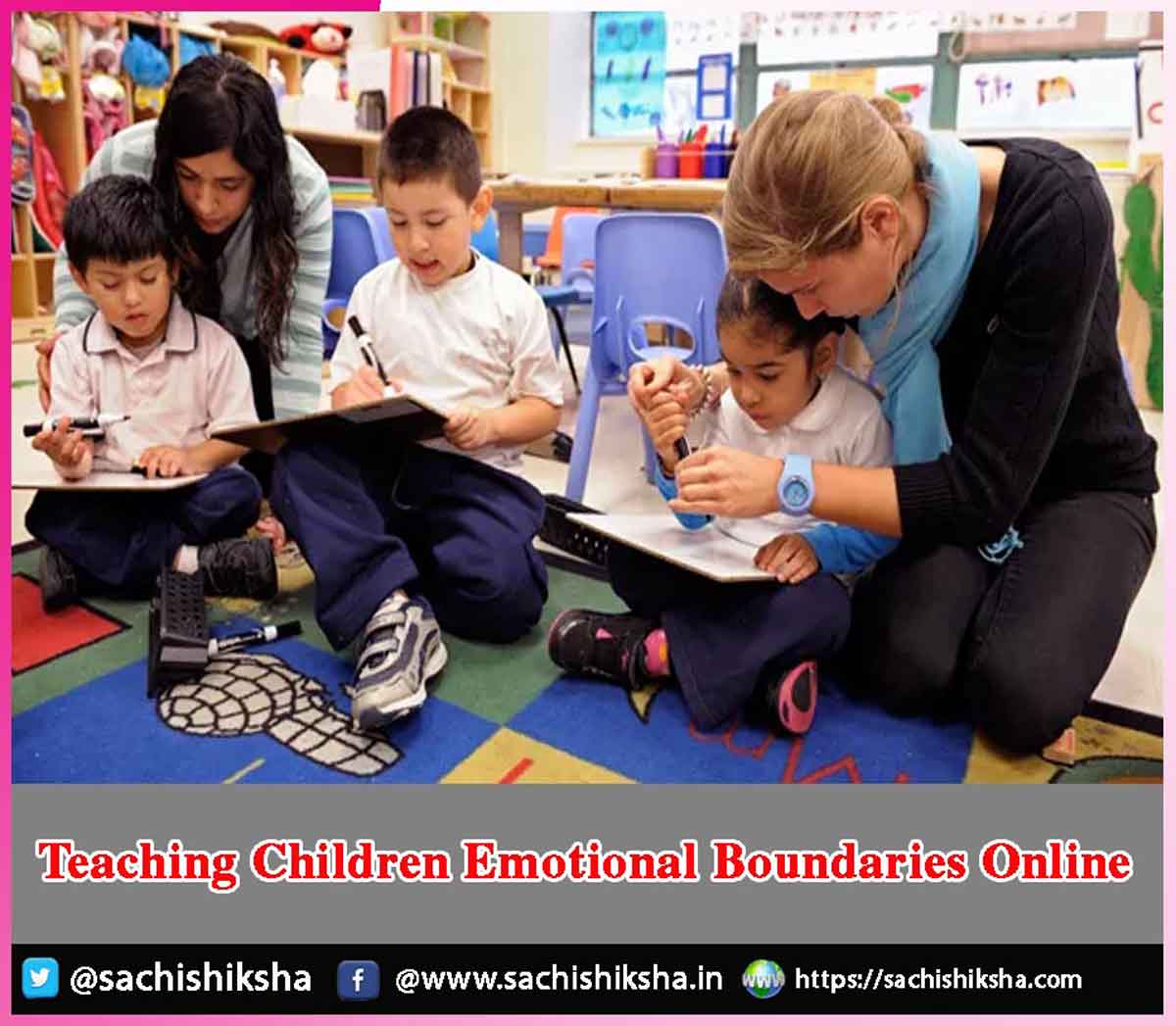Teaching Children Emotional Boundaries Online
Introduction: In the digital age, where social media, online gaming, and virtual learning environments are integral parts of children’s daily lives, teaching emotional boundaries online has become more critical than ever. Children today grow up with unprecedented access to the internet, which offers a multitude of opportunities but also brings challenges, particularly concerning emotional well-being, privacy, and online interactions. Emotional boundaries serve as invisible guidelines that help children understand how to express feelings appropriately, manage digital relationships, and protect themselves from emotional harm.
In today’s hyper-connected world, where digital interactions have become as common as face-to-face conversations, understanding emotional boundaries in online spaces is more important than ever—especially for children and adolescents. As young people navigate virtual classrooms, group chats, video calls, and social media platforms, they often encounter situations that challenge their sense of emotional safety and self-regulation.
Table of Contents
Understanding Emotional Boundaries

Emotional boundaries are the limits we set in relationships to protect our emotional well-being. They specify what information we feel safe disclosing, how we want to be addressed, and the way we react if another person goes above and beyond. In offline contexts, children begin to learn these boundaries through face-to-face experiences. Online, however, these cues are often invisible. Without body language, tone of voice, or facial expressions, it becomes more challenging to interpret intentions and gauge emotional responses. That’s why emotional boundaries in digital spaces require deliberate attention and practice.
Why Do Emotional Boundaries Matter Online?
-
Emotional Safety in a Boundless World
The internet can feel limitless. Messages, videos, and posts circulate around the clock, and young users may feel compelled to stay constantly engaged. This can lead to emotional exhaustion, especially when children feel pressured to respond immediately, maintain online popularity, or deal with conflicts via group chats and social networks. Boundaries allow them to create space between themselves and digital demands.
-
Preventing Emotional Exploitation
Online spaces are not immune to emotional manipulation. Children may encounter guilt-tripping, passive-aggressive messages, online shaming, or exclusion—all subtle forms of emotional abuse. Understanding boundaries helps them recognize such behaviors and take appropriate action, such as muting conversations, seeking help, or exiting harmful environments.
-
Maintaining Digital Self-Respect
Boundaries also reinforce self-worth. When children know they don’t have to respond to every message, share every feeling, or please everyone online, they gain a sense of control and confidence. They begin to distinguish between genuine digital friendships and those that are draining or toxic.
Types of Emotional Boundaries Online
-
Privacy Boundaries
This refers to decisions about what personal feelings, thoughts, or experiences one is comfortable sharing online. Children should understand that not every emotion needs to be posted or messaged. Teaching them to pause and reflect before sharing can prevent overexposure and protect them from judgment or unwanted attention.
-
Time Boundaries
Emotional boundaries also involve how much time children spend online. It’s important for them to learn that they don’t owe anyone 24/7 availability. Ignoring messages during meals, bedtime, or study hours is not rude—it’s a healthy boundary.
-
Response Boundaries
Children must understand that they are not responsible for fixing everyone’s problems or always being a digital support system.
-
Respect for Others’ Boundaries
Emotional boundaries go both ways. Children should also be taught to respect when others need space or don’t want to share. Pressuring someone to open up, spamming messages, or assuming availability can violate another person’s boundaries, even if unintentional.
How Can Parents and Educators Help?
-
Start Conversations Early
Talk to children about their online experiences. Ask open-ended questions like, “Has anyone ever said something online that made you uncomfortable?” This opens the door to deeper discussions about emotional boundaries.
-
Model Healthy Online Behavior
Adults should demonstrate boundary-setting themselves: turning off phones during dinner, taking digital breaks, and being mindful of their emotional responses online. Children often imitate adult behavior more than they follow instructions.
-
Teach Emotional Literacy
Help children label and understand their feelings. The better they can identify emotions like stress, pressure, or discomfort, the more confidently they can enforce boundaries when those emotions are triggered in digital settings.
-
Encourage Assertiveness
Teach children that it’s okay to say things like, “I don’t want to talk about this online,” or “I need some space right now.” Role-playing different scenarios can help them feel more comfortable asserting their emotional needs.
-
Teacher-Parent Collaboration
Regular communication between schools and parents ensures consistency in teaching emotional boundaries. Teachers can share online behavior observations. Schools should use moderated platforms for communication and collaboration. Enabling safe spaces teaches students appropriate digital engagement. Moreso, parents and teachers must gently address such signs as the sudden mood swings after screen time, and offer a non-judgmental space for discussion.
The Importance of Teaching Emotional Boundaries Online
-
Cyber bullying Prevention
Teaching children to recognize and establish emotional boundaries helps them avoid or respond appropriately to cyber bullying. When children know how to identify emotional manipulation or online harassment, they can better defend themselves and seek help when needed.
-
Healthy Digital Relationships
Online friendships and interactions can quickly turn toxic if boundaries are not respected. Children need guidance to manage conflicts, understand digital etiquette, and navigate social platforms responsibly.
-
Mental Health Protection
Emotional boundaries act as a safeguard against anxiety, stress, and emotional burnout caused by constant online exposure, peer pressure, and unrealistic comparisons on social media.
-
Autonomy and Identity
Setting limits helps kids become independent, have an established sense of identity, and stay away from external approval, which is prevalent on forums that prioritize likes, viewers, and opinions.
Challenges in the Digital World
-
Blurred Lines between Real and Virtual Worlds
Children often struggle to differentiate between real-life and online friendships, making it harder to recognize emotional manipulation or unhealthy dynamics.
-
Constant Connectivity
The always-on nature of digital communication fosters a belief that immediate responses are required, leading to stress, anxiety, and a lack of personal space.
-
Social Media Pressure
Platforms often promote effective behavior and peer comparison, which can push children to cross their own emotional comfort zones to fit in.
How to Teach Emotional Boundaries Online?
-
Start with Offline Lessons
Before introducing online contexts, children need a strong foundation in emotional literacy offline.
Teach emotional vocabulary: happy, sad, frustrated, embarrassed, etc.
Discuss body language and tone of voice.
Practice saying “no” respectfully and recognizing when others do the same.
-
Open Communication Channels
Encourage children to talk about their online experiences without fear of punishment. Use open-ended question:
“How do you respond if somebody annoys you on the online world?”
-
Model Healthy Boundaries
Children learn by example. Parents and teachers should demonstrate model healthy boundaries.
-
Set and Discuss Digital Rules
Create clear guidelines for online interactions:
Don’t share passwords, even with friends.
Think before posting emotional content.
Ask before tagging or sharing someone else’s photo.
Frequently go over these guidelines with the youngster and make revisions as they mature.
-
Teach Privacy as a Form of Emotional Boundary
Teach kids that not all information should be disclosed digitally. Teach them to ask:
“Would I feel comfortable if everyone saw this?”
This helps children practice their responses and build emotional resilience.
Age-Specific Guidance
For Younger Children (5–9 years)
Focus on Feelings: Use games and stories to explain emotional reactions.
Teach Simple Digital Rules: “Ask before you share,” “Tell a grown-up if someone makes you uncomfortable.”
Monitor screen time closely and co-view content.
For Children (10–12 years)
Introduce social media use gradually with supervision.
Discuss Digital Etiquette: Respecting privacy, not over sharing, and how to say no.
Reinforce the idea that their emotions are valid and need protection online.
For Teens (13+)
Foster Critical Thinking: Encourage analysis of emotional tone in posts or messages.
Benefits of Teaching Emotional Boundaries Online
Improved Mental Health : Children with strong boundaries experience lower anxiety and depression rates.
- Better Academic Focus: Emotional security translates into better concentration and learning.
- Resilient Relationships: Children learn to build and maintain respectful digital friendships.
- Empowered Decision-Making: Knowing their emotional limits helps children make wise online choices.
Conclusion
In an age where digital interactions are intertwined with everyday life, teaching children the emotional boundaries online is not optional—it is essential. These boundaries empower children to navigate the online world safely, communicate with empathy, and protect their mental and emotional well-being. The task requires a collaborative effort between parents, educators, and communities. With the right tools, guidance, and support, children can grow into emotionally intelligent and digitally responsible individuals, ready to face the challenges of a connected world.















































